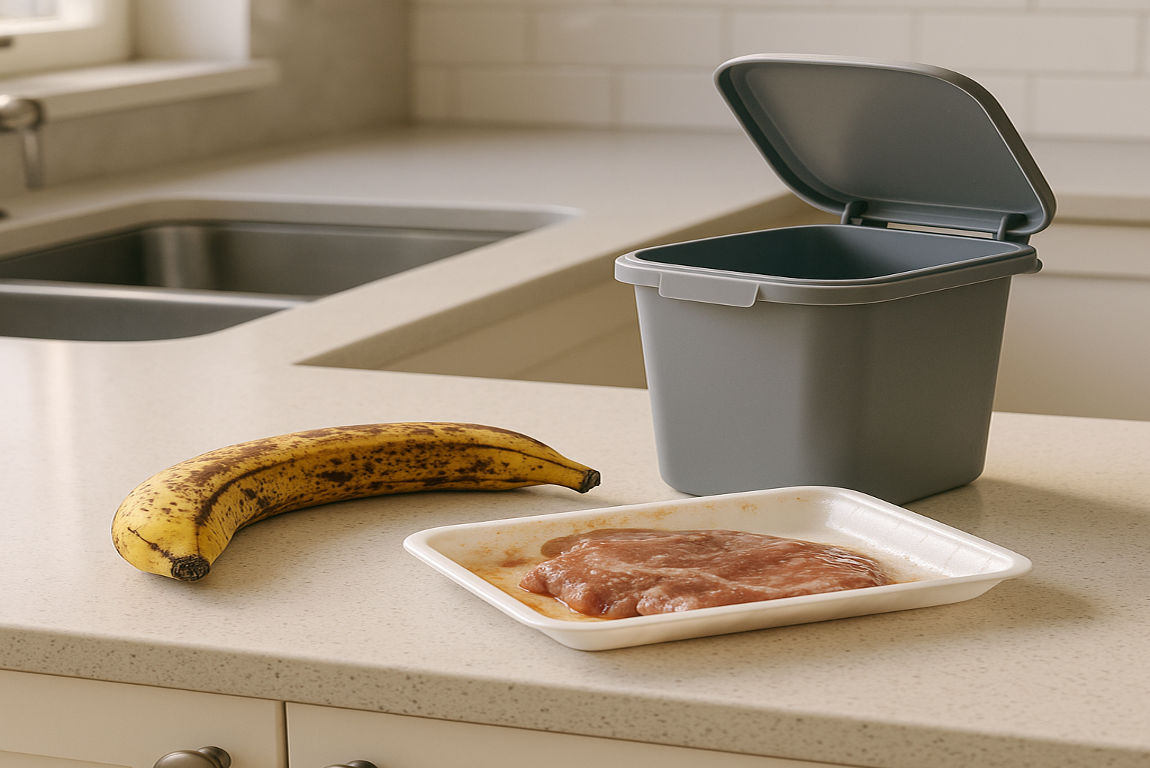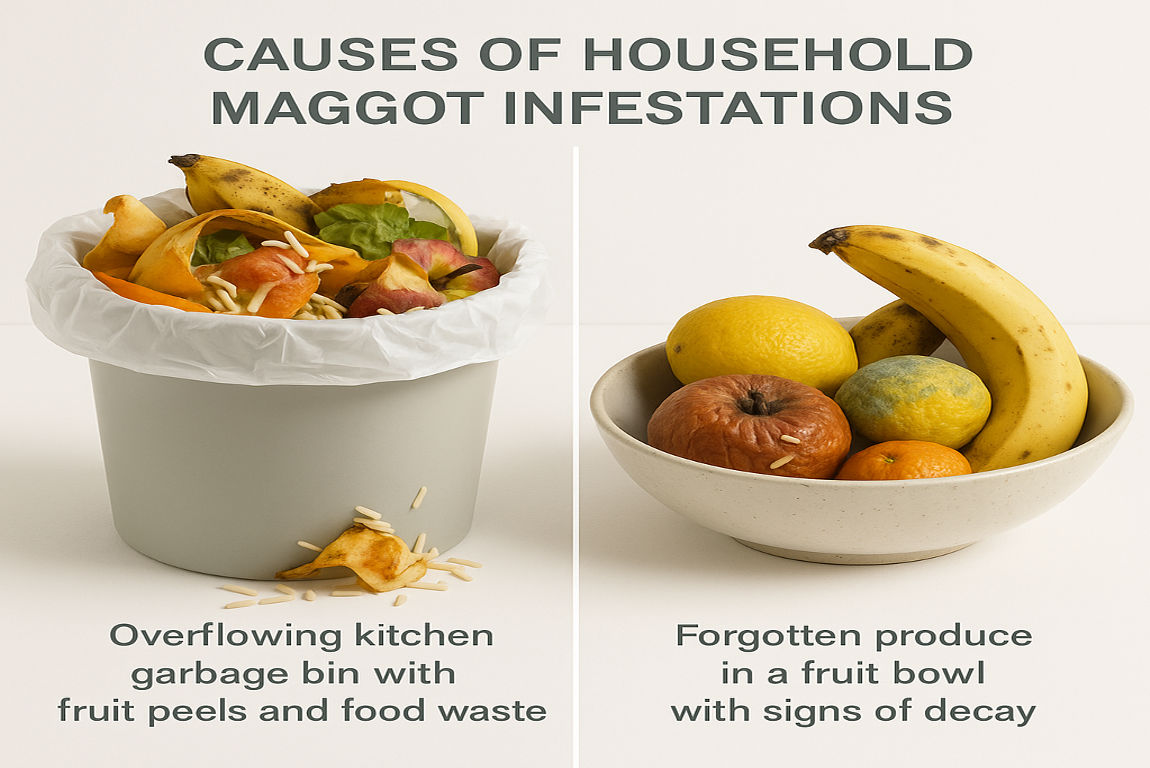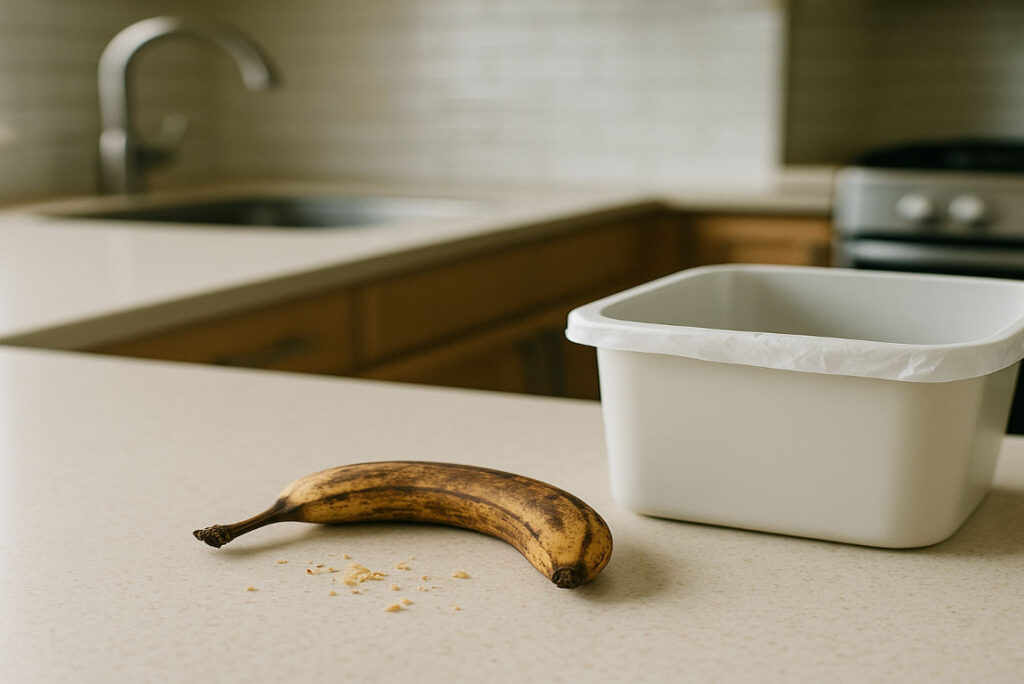Imagine this: You walk into your kitchen, ready to grab a snack, and suddenly, you notice tiny, wriggling creatures on the floor or in your trash can. Maggots. The sight alone is enough to make anyone cringe. But how did they get there? What would cause maggots to be in your house, and more importantly, how can you prevent them?
What Are Maggots?

Before we explore the causes, let’s first understand what maggots are and why they appear.
Definition of Maggots
Maggots are the larval stage of flies, specifically houseflies, fruit flies, and other common species. They are part of the fly’s life cycle and play a crucial role in breaking down decaying organic matter in nature. While they may serve an ecological purpose outdoors, their presence indoors is a sign of a problem.
What Do Maggots Look Like?
Maggots are small, white, worm-like creatures. They are typically about 3-12 millimeters long, with a tapered body and no legs. Their appearance is unmistakable and often unsettling.
Common Types of Flies That Cause Maggots Indoors
The most common culprits behind maggot infestations in homes are:
- Houseflies: These are the most frequent visitors to trash bins and decaying food.
- Fruit Flies: Attracted to overripe fruits and sugary residues.
- Blowflies: Often associated with dead animals or decaying meat.
Understanding what maggots are and their origin is the first step in addressing the problem.
You may also read (protect your investment with home improvement insurance).
The Lifecycle of a Fly
To effectively prevent maggots, it’s essential to understand the lifecycle of a fly. Flies reproduce quickly, and their lifecycle explains how maggots appear seemingly out of nowhere.
Egg Stage
Flies lay their eggs in decaying organic matter, such as food waste, garbage, or dead animals. A single fly can lay hundreds of eggs at a time, and these eggs are often too small to notice.
Larvae Stage (Maggots)
Within 24 hours, the eggs hatch into maggots. These larvae feed on the organic material around them, growing rapidly. This is the stage where you’ll notice their presence.
Pupa Stage
After feeding, maggots enter the pupa stage, where they form a cocoon and begin transforming into adult flies.
Adult Fly Stage
Once the transformation is complete, adult flies emerge, ready to reproduce and start the cycle again.
Why This Matters for Homes
Understanding this lifecycle helps you identify and eliminate the source of maggots before they mature into flies. Breaking the cycle is key to preventing infestations.
What Would Cause Maggots to Be in My House?

Maggots don’t appear out of thin air. Their presence indicates specific conditions that attract flies and allow them to lay eggs. Let’s explore the most common causes.
Decaying Organic Matter
Flies are drawn to anything that’s rotting or decomposing. Here are the main culprits:
- Food Waste: Leftover food, especially meat, fruits, and vegetables, is a magnet for flies. If food isn’t stored properly or disposed of quickly, it becomes a breeding ground.
- Garbage Bins: Overflowing or unclean trash bins are one of the most common sources of maggots. Flies can easily access the waste and lay eggs.
- Pet Food: Leftover pet food, especially wet food, can attract flies if not cleaned up promptly.
Dead Animals
Sometimes, maggots appear due to the presence of a dead animal in or around your home.
- Rodents or Birds: If a rodent or bird dies in your walls, attic, or basement, it can attract flies, leading to maggot infestations.
- Signs of a Dead Animal: A foul odor, flies congregating in one area, or unexplained maggots can indicate a dead animal nearby.
Poor Sanitation
A lack of cleanliness can create the perfect environment for flies to thrive.
- Dirty Drains: Clogged or dirty drains often harbor organic matter that attracts flies.
- Unclean Surfaces: Crumbs, spills, and grease left on counters or floors can contribute to infestations.
Open Windows and Doors
Flies can easily enter your home through open windows and doors, especially if there are no screens in place. Once inside, they’ll search for food or waste to lay their eggs.
Seasonal Factors
Certain environmental conditions increase the likelihood of maggot infestations.
- Warm Weather: Flies are more active in summer, increasing the chances of infestations.
- Humidity: High humidity accelerates the decomposition of organic matter, attracting flies.
You may also read (transform your home with creative bedroom ideas).
Health Risks Associated with Maggots in the House

Maggots aren’t just unpleasant to look at—they can pose serious health risks.
Bacterial Contamination
Maggots can spread harmful bacteria, such as Salmonella and E. coli, which can cause food poisoning and other illnesses.
Food Contamination
If maggots come into contact with your food, they can contaminate it, making it unsafe to eat.
Allergic Reactions
Some people may experience allergic reactions to maggots or the flies that produce them.
Psychological Impact
The sight of maggots can cause significant discomfort, stress, and anxiety, especially during severe infestations.
How to Prevent Maggots in Your House
Prevention is always better than cure. Here are practical steps to keep maggots out of your home.
Proper Waste Management
- Sealed Trash Bins: Use bins with tight-fitting lids to prevent flies from accessing waste.
- Regular Trash Disposal: Remove the trash frequently, especially during warm weather.
Cleanlines and Hygiene
- Clean Surfaces: Wipe down counters and clean up spills immediately.
- Regular Drain Cleaning: Use drain cleaners or natural solutions, such as baking soda and vinegar, to keep your drains clean.
Food Storage
- Sealed Containers: Store food in airtight containers to keep flies away.
- Refrigeration: Refrigerate perishable items promptly.
Pest Control Measures
- Fly Screens: Install screens on windows and doors to keep flies out.
- Fly Traps: Use fly traps or zappers to reduce fly populations.
- Professional Pest Control: Call a professional for severe infestations.
How to Get Rid of Maggots in Your House

If you already have maggots, here’s how to eliminate them effectively.
Immediate Cleanup
- Remove the Source: Locate and remove the source of the infestation, such as food waste or a dead animal.
- Dispose of Maggots: Seal maggots in a bag and throw them away.
Cleaning and Disinfecting
- Hot Water and Soap: Clean affected areas with hot water and soap.
- Disinfectants: Use disinfectants to kill bacteria and eliminate odors.
Natural Remedies
- Salt and Lime: Sprinkle salt or lime on maggots to kill them.
- Boiling Water: Pour boiling water over maggots for an immediate solution.
Chemical Solutions
- Insecticides: Use insecticides designed for maggots, following safety instructions carefully.
Common Myths About Maggots in the House
Let’s debunk some common misconceptions about maggots.
Maggots Only Appear in Dirty Homes
Even clean homes can attract flies if food is left out or trash isn’t disposed of properly.
Maggots Can Appear Spontaneously
Maggots don’t appear out of nowhere—they come from fly eggs.
Maggots Are Harmless
While they may seem harmless, maggots can spread bacteria and contaminate food.
When to Call a Professional
Sometimes, professional help is necessary.
- Severe Infestations: If maggots are widespread, it’s time to call a pest control expert.
- Dead Animal Removal: Professionals can safely remove dead animals in hard-to-reach areas.
- Recurring Issues: Persistent infestations may indicate a larger problem that needs expert attention.
You may also read (house sigma your guide to accurate home pricing).
